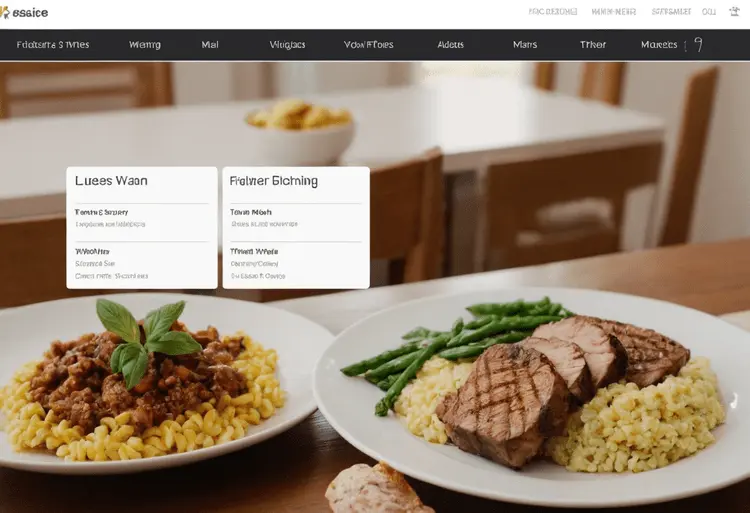Resident Diet System: Your Ultimate Guide to Navigating Nutritional Needs in Care
Are you overwhelmed by the complexities of balancing resident dietary needs, preferences, and regulations within your care facility?
Do terms like food service systems for long-term care, personalized meal plans for residents, and therapeutic diets for residents sound more like a headache than a solution?
Imagine a streamlined system that not only addresses these challenges but also elevates the quality of life for your residents.
A resident diet system can be that solution, whether you’re exploring software for resident meal planning or seeking effective ways to manage food allergies in care homes.
This comprehensive guide will walk you through every step of creating a successful resident diet system, ensuring optimal nutrition, satisfaction, and regulatory compliance.
Dive in and discover how to transform mealtime into a highlight of the day for everyone in your care.
Resident Diet Systems at a Glance
- Holistic nutrition approach
- Personalized meal plans
- Improves resident well-being
- Streamlines care facility operations
- Tech-enhanced solutions available
The Foundation of Nourishing Lives: Resident Diet Systems Unveiled

Let’s face it: Food isn’t just fuel – it’s comfort, joy, and a cornerstone of health. And for individuals in care settings, it’s even more crucial.
Have you ever wondered how we can ensure that every resident receives meals that are both delicious and tailored to their unique needs? The answer lies in a robust resident diet system.
A resident diet system is far more than just a meal plan. It’s a comprehensive, dynamic approach to managing every aspect of nutrition within a care setting.
Think of it as the backbone of a healthy lifestyle, ensuring residents not only get the nutrients they need but also the flavors they love.
This guide will unlock the secrets behind successful resident diet systems, exploring their benefits, components, and how they enhance the lives of those in our care.
Whether you’re a healthcare professional, a caregiver, or simply someone curious about nutrition, this journey is for you.
What Exactly Is a Resident Diet System?
It’s more than meets the eye. A resident diet system encompasses everything from assessing individual nutritional needs and preferences to creating personalized menus, preparing meals, and evaluating their impact.
It’s a symphony of processes designed to promote well-being and cater to diverse tastes.
Did you know that a well-implemented resident diet system can significantly improve residents’ health outcomes? From managing chronic conditions like diabetes to preventing malnutrition, proper nutrition plays a pivotal role.
It’s about empowering people to live their best lives through the simple act of eating well.
Why Does Nutrition Matter So Much in Care Settings?
In care settings, the stakes are high. The food we provide isn’t just sustenance; it’s medicine. A carefully crafted resident diet system can prevent and manage a range of health issues, from pressure ulcers to heart disease.
But it goes beyond physical health. Nourishing food brings joy, fosters social connections, and even helps with mental well-being. It’s a powerful tool that can make all the difference in the quality of life for those under our care.
And for health-conscious readers, a well-structured resident diet system should align with the latest dietary guidelines, such as those outlined in the Dietary Guidelines for Americans, 2020-2025, ensuring a balance of nutrients and promoting overall health.
Are you ready to explore the incredible world of resident diet systems? Join us as we delve deeper into their different types, the cutting-edge features they offer, and how to implement them effectively. Share your thoughts, experiences, or questions in the comments below or tag us on social media. We’d love to hear from you!
Types of Resident Diet Systems: A Taste of Variety
One size doesn’t fit all, especially when it comes to food. There are various types of resident diet systems, each with its own strengths and weaknesses.
From manual systems that rely on paper-based records to sophisticated electronic systems that streamline processes, the choices are vast.
Have you ever considered the impact of different resident diet system models? Each model, whether centralized, decentralized, or a hybrid, can influence the efficiency of meal preparation, the accuracy of dietary information, and ultimately, the satisfaction of residents.
We’ll uncover the pros and cons of each type, giving you the knowledge to make informed decisions for your specific needs.
So, stay tuned for an in-depth look at the components that make these systems tick. Get ready to discover how technology is transforming the way we nourish and care for our residents.
Your resident diet system is already top-notch, but there’s a hidden gem that can take it to the next level: probiotics. Discover how these gut-friendly powerhouses can revolutionize your residents’ health and well-being.
Components and Features of Modern Resident Diet Systems

Ever wondered how care facilities ensure their residents are nourished and happy with their meals? Enter the modern resident diet system, a powerhouse of features designed to personalize nutrition and streamline meal management.
Core Components of a Resident Diet System
The cornerstone of any effective resident diet system lies in its core components. These essential elements work together to create a seamless and nourishing experience for residents.
- Resident Assessment and Nutritional Screening:
Think of this as the foundation. Before crafting a meal plan, we need to know the individual. What are their preferences, allergies, medical conditions, and cultural backgrounds? This information is key to crafting a resident diet system that truly nourishes.
- Menu Planning and Development:
This is where the magic happens! Cycle menus, seasonal variations, cultural considerations, and therapeutic diets all come into play. Remember, it’s not just about calories and nutrients.
It’s about creating meals that excite and satisfy. If you’re curious about the nutritional needs of older adults, be sure to check out the Dietary Guidelines for Americans, 2020-2025.
- Ordering and Production:
Efficiency is key. Modern resident diet systems streamline the ordering process, manage inventory, and ensure meals are prepared according to resident choices. This means less waste and more personalized nutrition.
- Meal Delivery and Service:
It’s not just about the food; it’s about the experience. Tray delivery, dining room service, and room service options all have their place. Presentation, ambiance, and social interaction can significantly impact how residents perceive their meals.
- Monitoring and Evaluation:
Data-driven decisions are the future. Modern resident diet systems track resident intake, weight changes, and satisfaction levels. Regular audits and reviews ensure the system is working as intended.
Advanced Features: Taking Resident Diet Systems to the Next Level
Modern resident diet systems are constantly evolving. Here are some cutting-edge features that are transforming the way we approach nutrition in care settings:
- Electronic Health Records (EHR) Integration:
Seamless data sharing between diet systems and medical records ensures a holistic approach to care. This means better coordination between healthcare providers and more informed decisions about dietary needs.
- Adaptive Equipment and Utensils:
Empowering residents with disabilities to eat independently is a priority. Adaptive utensils and equipment, like those available from various online retailers, make mealtime enjoyable and accessible for everyone.
- Mobile Applications:
Who doesn’t love convenience? Mobile apps allow residents to view menus, make selections, and provide feedback from the comfort of their own devices.
- Artificial Intelligence (AI) and Machine Learning (ML):
These technologies are game-changers. AI can personalize menus, predict food preferences, and optimize inventory management, while ML learns from resident feedback to continuously improve the system.
What are your thoughts on these advanced features? Have you seen them in action? Share your experiences in the comments below or tag us on social media!
Implementing and Optimizing Your Resident Diet System: From Chaos to Culinary Care
Have you ever felt overwhelmed by the sheer number of dietary needs in your care setting? Allergies, preferences, medical restrictions… it’s a lot to juggle!
But what if I told you that a well-implemented resident diet system could transform mealtimes from a headache into a highlight? Let’s dive in and explore how to make that happen.
Implementation Strategies: Building Your Nutritional Roadmap
The Power of a Thorough Needs Assessment Before diving into software demos, take a step back. Conduct a comprehensive needs assessment.
What resources do you have? What are your staff’s strengths? What’s the diversity of your resident population? Understanding your unique needs is the cornerstone of choosing the right system.
Selecting Your Culinary Compass: The Right System There’s no one-size-fits-all solution. Do you need a system that integrates with your electronic health records (EHR)?
Are you looking for advanced features like adaptive equipment recommendations or mobile apps for resident input? Align your choice with your goals, budget, and technological comfort level.
Empowering Your Crew: Staff Training and Education A shiny new resident diet system is only as good as the people using it. Invest in thorough training for your staff.
When they understand the “why” behind the system and how to use it effectively, they become your biggest advocates for change.
Easing into Excellence: Gradual Rollout Don’t rush into a complete overhaul. A phased approach allows you to iron out any kinks, gather feedback, and adjust as needed. Remember, Rome wasn’t built in a day, and neither is a successful resident diet system.
Best Practices for Optimization: Nourishing Continuous Improvement
Open the Lines of Communication: Feedback is Your Friend Encourage open communication between staff, residents, and families. What’s working?
What could be improved? This valuable feedback loop helps you fine-tune your resident diet system and create a truly personalized experience.
Quality is a Journey, Not a Destination: Continuous Improvement The world of nutrition is always evolving. New research emerges, resident needs change, and technology advances.
Regularly review and update your system to ensure it remains effective, relevant, and aligned with best practices as outlined in the Dietary Guidelines for Americans, 2020-2025.
Embrace the Tech Revolution:
Don’t be afraid to explore new technologies. Mobile apps can empower residents to make their own choices, while AI can analyze data to personalize menus and optimize inventory. The future of food is here!
Let’s Chat! Share your experiences with implementing a resident diet system in the comments below. Have you encountered any challenges? Discovered any unexpected benefits? We’re all in this together, so let’s learn from each other!
Special Considerations and Dietary Restrictions: Tailoring the Resident Diet System for Individual Needs
Let’s face it – not everyone has the same nutritional needs. Have you ever wondered how a resident diet system caters to individuals with unique dietary restrictions? The answer lies in personalization and flexibility.
Common Dietary Restrictions in Care Settings: A Personalized Approach
In the realm of long-term care, various dietary restrictions come into play. Dysphagia, the medical term for swallowing difficulties, often necessitates texture-modified diets.
From pureed foods to minced and moist options, a resident diet system ensures safe and enjoyable meals for individuals with dysphagia.
Are you familiar with the dietary needs of residents with diabetes? Carbohydrate control takes center stage, with tailored meal plans that manage blood sugar levels while offering a delectable array of choices.
Renal disease, on the other hand, requires restrictions on protein, potassium, phosphorus, and fluids. The resident diet system steps up to the challenge, crafting meals that adhere to these vital limitations.
But what about food allergies and intolerances? A robust resident diet system meticulously identifies and eliminates allergens, replacing them with equally satisfying alternatives. It’s about fostering inclusivity and ensuring everyone enjoys their meals without worry.
Addressing Cultural and Religious Preferences: A Tapestry of Flavors
The beauty of a resident diet system lies in its ability to embrace diversity. Have you ever considered how cultural and religious preferences influence meal choices?
From incorporating diverse cuisines to accommodating fasting practices and dietary laws like kosher and halal, the system celebrates the richness of individual backgrounds.
Nutritional Information for Health-Conscious Readers: Did you know that a well-designed resident diet system not only caters to restrictions but also provides valuable nutritional information?
Each meal is carefully crafted to meet specific dietary guidelines, ensuring residents receive the right balance of macronutrients and micronutrients.
This information empowers residents and their families to make informed choices about their diet and overall health.
End-of-Life Care and Comfort Foods: Nourishing Body and Soul
As we age, our dietary needs and preferences evolve. In end-of-life care, comfort takes precedence.
The resident diet system shifts its focus to offering familiar favorites and flexible mealtimes, allowing residents to savor the simple joys of food. It’s about nourishing not only the body but also the soul.
The Future of Resident Diet Systems: A Glimpse into Personalized, Tech-Driven Nutrition
Ever wondered what the future holds for the food on your plate? Especially in care settings where dietary needs are complex and diverse? The answer is both exciting and transformative, as technology revolutionizes how we approach nutrition for residents.
Embracing Personalization: Beyond “One-Size-Fits-All”
Imagine resident diet systems that cater to individual preferences, allergies, and health goals. Thanks to advancements in genetic testing and microbiome analysis, personalized nutrition is no longer a distant dream.
These technologies allow us to understand how our bodies uniquely respond to different foods, paving the way for truly customized meal plans.
Tech-Powered Dining: A Feast for the Senses
3D food printers are making waves, offering the potential to create visually appealing, nutrient-rich meals with the push of a button.
Virtual reality (VR) is also stepping into the dining room, offering immersive experiences for residents with limited mobility or sensory impairments. Imagine enjoying a virtual beachside picnic while savoring a delicious, healthy meal – the possibilities are endless.
Artificial Intelligence: The Smartest “Chef” in the Kitchen
Artificial intelligence (AI) and machine learning are poised to revolutionize resident diet systems. AI can analyze vast amounts of data to optimize menu planning, predict food shortages, and even identify residents at risk of malnutrition.
Meanwhile, machine learning algorithms can continuously learn from resident feedback, ensuring that meals are both delicious and nutritious.
Nourishing Futures with Resident Diet Systems

So, have we whet your appetite for change? A well-implemented resident diet system is more than just meals; it’s a cornerstone of health, happiness, and regulatory peace of mind.
Have you ever wondered how to seamlessly integrate a resident diet system with your existing healthcare software? Or perhaps, you’re curious about the latest nutritional guidelines for elderly individuals?
In fact, the right system streamlines your workflow, empowers your residents, and even enhances your bottom line. But here’s the question: Is your current approach truly serving your community’s needs? If not, it’s time to explore the possibilities.
- Ready to dig deeper? Leave your questions and thoughts in the comments below. Let’s spark a conversation about how we can elevate nutrition in care settings together.
- Want to stay in the loop? Tag us on social media with your resident diet system success stories. We’re eager to see how you’re making a difference!
Remember, the future of food in care settings is brighter than ever. And with a well-designed resident diet system, you’re not just feeding your residents; you’re nourishing their lives.
Your resident diet system is dialed in, but are you looking to offer even more variety and flexibility? Explore a world of flavor-packed, nutritious 500-calorie meals that cater to dietary needs and keep residents
Let’s Chat About Resident Diet Systems
Curious about resident diet systems? Wondering how to tailor meals to individual needs and preferences? Let’s dive into some common questions!
Regularly gather feedback, offer choices, honor preferences, and focus on presentation and taste.
Aim for an initial assessment upon admission, then annually, and whenever their health changes significantly.
Regulations vary by location. Generally, they cover providing enough nutritious food, accommodating dietary restrictions, and keeping accurate records.
Get creative with colorful fruits and veggies, whole grains, and lean proteins. Offer tasty, nutrient-rich snacks, and make hydration fun.